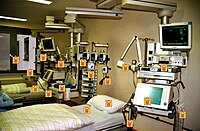
Photo from wikipedia
Sutures are used to facilitate wound healing and play an important role in ensuring the success of surgical interventions in healthcare facilities. Suture-associated surgical site infection (SSI) may develop when… Click to show full abstract
Sutures are used to facilitate wound healing and play an important role in ensuring the success of surgical interventions in healthcare facilities. Suture-associated surgical site infection (SSI) may develop when bacterial contaminants colonize the suture surface and establish biofilms that are highly resistant to antibiotic treatment. The outcome of SSI affects postoperative care, leading to high rates of morbidity and mortality, prolonged hospitalization, and increased financial burden. Antimicrobial sutures coated with antiseptics such as triclosan and chlorhexidine have been used to minimize the occurrence of SSI. However, as the efficacy of antiseptic-based sutures may be affected due to the emergence of resistant strains, new approaches for the development of alternative antimicrobial sutures are necessary. This review provides an update and outlook of various approaches in the design and development of antimicrobial sutures. Attaining a zero SSI rate will be possible with the advancement in suturing technology and implementation of good infection control practice in clinical settings.
Journal Title: European review for medical and pharmacological sciences
Year Published: 2022
Link to full text (if available)
Share on Social Media: Sign Up to like & get
recommendations!